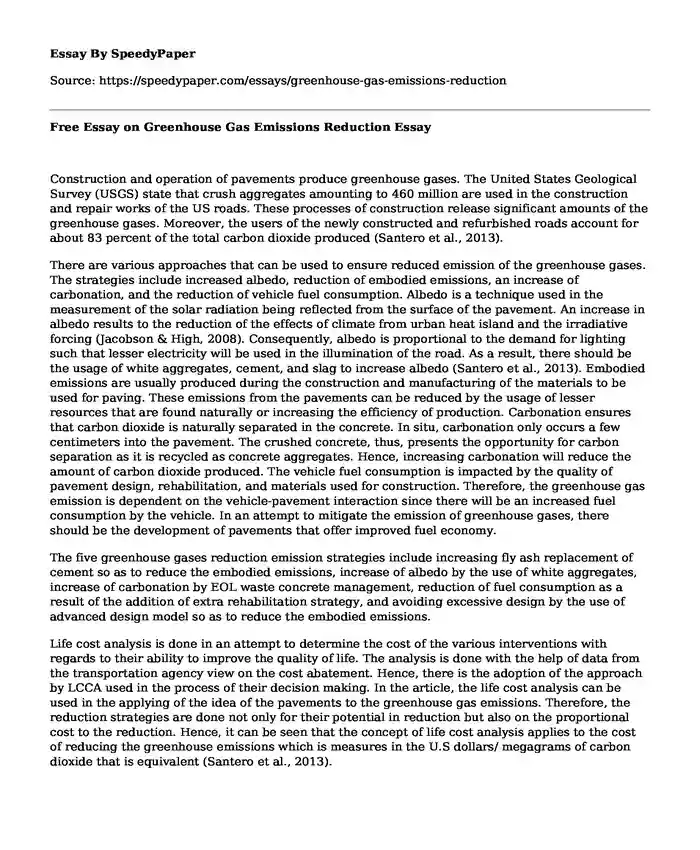
| Type of paper: | Case study |
| Categories: | Air pollution |
| Pages: | 3 |
| Wordcount: | 596 words |
Construction and operation of pavements produce greenhouse gases. The United States Geological Survey (USGS) state that crush aggregates amounting to 460 million are used in the construction and repair works of the US roads. These processes of construction release significant amounts of the greenhouse gases. Moreover, the users of the newly constructed and refurbished roads account for about 83 percent of the total carbon dioxide produced (Santero et al., 2013).
There are various approaches that can be used to ensure reduced emission of the greenhouse gases. The strategies include increased albedo, reduction of embodied emissions, an increase of carbonation, and the reduction of vehicle fuel consumption. Albedo is a technique used in the measurement of the solar radiation being reflected from the surface of the pavement. An increase in albedo results to the reduction of the effects of climate from urban heat island and the irradiative forcing (Jacobson & High, 2008). Consequently, albedo is proportional to the demand for lighting such that lesser electricity will be used in the illumination of the road. As a result, there should be the usage of white aggregates, cement, and slag to increase albedo (Santero et al., 2013). Embodied emissions are usually produced during the construction and manufacturing of the materials to be used for paving. These emissions from the pavements can be reduced by the usage of lesser resources that are found naturally or increasing the efficiency of production. Carbonation ensures that carbon dioxide is naturally separated in the concrete. In situ, carbonation only occurs a few centimeters into the pavement. The crushed concrete, thus, presents the opportunity for carbon separation as it is recycled as concrete aggregates. Hence, increasing carbonation will reduce the amount of carbon dioxide produced. The vehicle fuel consumption is impacted by the quality of pavement design, rehabilitation, and materials used for construction. Therefore, the greenhouse gas emission is dependent on the vehicle-pavement interaction since there will be an increased fuel consumption by the vehicle. In an attempt to mitigate the emission of greenhouse gases, there should be the development of pavements that offer improved fuel economy.
The five greenhouse gases reduction emission strategies include increasing fly ash replacement of cement so as to reduce the embodied emissions, increase of albedo by the use of white aggregates, increase of carbonation by EOL waste concrete management, reduction of fuel consumption as a result of the addition of extra rehabilitation strategy, and avoiding excessive design by the use of advanced design model so as to reduce the embodied emissions.
Life cost analysis is done in an attempt to determine the cost of the various interventions with regards to their ability to improve the quality of life. The analysis is done with the help of data from the transportation agency view on the cost abatement. Hence, there is the adoption of the approach by LCCA used in the process of their decision making. In the article, the life cost analysis can be used in the applying of the idea of the pavements to the greenhouse gas emissions. Therefore, the reduction strategies are done not only for their potential in reduction but also on the proportional cost to the reduction. Hence, it can be seen that the concept of life cost analysis applies to the cost of reducing the greenhouse emissions which is measures in the U.S dollars/ megagrams of carbon dioxide that is equivalent (Santero et al., 2013).
References
Jacobson, D., & High, C. (2008). Wind energy and air emission reduction benefits. Golden, Colo.: National Renewable Energy Laboratory.
Santero, N., Loijos, A., & Ochsendorf, J. (2013). Greenhouse Gas Emissions Reduction Opportunities for Concrete Pavements.
Cite this page
Free Essay on Greenhouse Gas Emissions Reduction. (2022, Jun 20). Retrieved from https://speedypaper.com/essays/greenhouse-gas-emissions-reduction
Request Removal
If you are the original author of this essay and no longer wish to have it published on the SpeedyPaper website, please click below to request its removal:
- Racial Discrimination Essay Example for Your Free Use
- Essay Sample on the Theme of Oppression in Marriage in The Story Of An Hour
- Nutrition Essay Sample: Components of a Balanced Diet
- Critical Response to "Eat that Frog!" book by Brian Tracy
- Essay Example on Gender Stereotyping in the Society
- Private Property: Smith's Perspective on Helping Those in Need
- Free Essay Sample - Gaining Trust With Cultural Disparities
Popular categories




